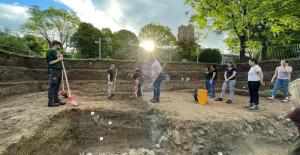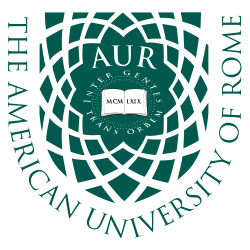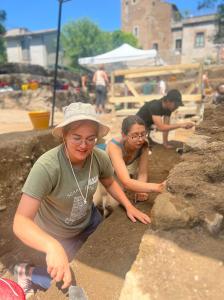Unearthing “Little Aventine”: The Aventinus Minor Project: Progress & Promise
Archaeologists and students uncover Rome’s Aventinus Minor in a project blending excavation, research, and community engagement led by AUR.
ROME, ROMA, ITALY, September 23, 2025 /EINPresswire.com/ -- The Aventinus Minor Project (AMP), launched in 2019, has become one of the most ambitious community-archaeological undertakings in central Rome. Led by The American University of Rome (AUR) in partnership with St. Stephen’s School, Rome, the Istituto Santa Margherita, and the Soprintendenza Speciale Archeologia Belle Arti e Paesaggio di Roma, the project combines rigorous academic research with hands-on pedagogy and strong local engagement.
AMP explores Rome’s “Little Aventine” (Aventinus Minor), a green, largely unstudied stretch of the San Saba neighborhood between the Baths of Caracalla and the Circus Maximus. The area, owned by the Istituto Santa Margherita and bordering the monastery of Santa Balbina, may preserve intact layers of history stretching from modern times back to the city’s earliest foundations.
Early research points to the presence of the Republican Servian Wall, Imperial-era houses (including that of Lucius Fabius Cilo, consul in 193 & 204 CE), and the early Christian church of Santa Balbina.
The Three Pillars of the project: Research, Pedagogy, and Community
Research: AMP employs both non-invasive and invasive methods, including ground-penetrating radar, aerial photography, GIS mapping, archival study, artifact analysis, and stratigraphic excavation.
Pedagogy: Students are central to AMP. High-schoolers from St. Stephen’s and undergraduates and graduates from AUR work side-by-side with faculty and professional archaeologists, taking part in surveys, documentation, excavation trenches, artifact cataloguing, and lab analysis. For many, it is their first experience of archaeological excavation.
Community: The project engages local residents through bilingual lectures, exhibitions, posters, and open-house events, ensuring that discoveries are shared beyond academic circles.
Project Achievements to Date
1. Remote sensing and GIS (2020–2021)
During the pandemic, when field access was restricted, AMP advanced archival and cartographic work, aligning historic maps with modern data and building a GIS framework for the site.
2. Surveying and initial excavation (2021 onward)
Once on-site, the team conducted GPR surveys, drone imaging, and photogrammetry, and began targeted excavation in areas of greatest interest. Students have opened and recorded trenches, studied stratigraphy, and processed artifacts - linking classroom theory directly with hands-on discovery.
3. Academic and public outputs
Results have been published in peer-reviewed journals and at conferences. At the same time, exhibitions and talks in the San Saba neighborhood have made the project accessible to a broad audience.
4. Pedagogical impact
Dozens of AUR students have received academic credit for their participation, building practical skills in excavation, survey methods, GIS, and lab analysis. Many alumni of AMP are already pursuing careers or graduate study in heritage and archaeology.
--------
AUR faculty - including professors Elizabeth Wueste, Giulia Facchin, and Pier Matteo Barone - have been instrumental in shaping the entire project - from research strategy to securing excavation permits, and directing the scientific work. AUR students, meanwhile, have been far more than observers: they have helped to open trenches, record stratigraphy, catalogue finds, and bring the project’s results to both scholarly and public audiences.
Challenges & Next Steps:
Like all urban archaeology, AMP must navigate complex challenges: funding, access, and the unpredictability of stratigraphy beneath a living city. Looking forward, the team plans further excavation seasons to verify anomalies identified in surveys, additional academic publications, and expanded community programming. Plans may also include new AUR coursework and internships tied directly to AMP’s work.
Why the Aventinus Minor Matters
The Aventinus Minor site is one of the last relatively unexplored plots in Rome’s historic core. Its intact stratigraphy could illuminate how the city’s fabric evolved across millennia, from Republican to Imperial, early Christian, medieval, and modern times.
Equally, AMP offers a model of how an archaeological project can integrate high-level research, experiential student learning, and community outreach.
From its beginnings in 2019, the Aventinus Minor Project has made impressive strides - growing into both a living educational laboratory and a vital contribution to Rome’s cultural heritage - an initiative that promises to keep unearthing new insights for years to come.
You will find much more detail on the project and its progress on the dedicated AMP website at https://www.aventinusminor.org/
Henry James Greiner
The American University of Rome
email us here
Visit us on social media:
LinkedIn
Instagram
Facebook
YouTube
TikTok
Legal Disclaimer:
EIN Presswire provides this news content "as is" without warranty of any kind. We do not accept any responsibility or liability for the accuracy, content, images, videos, licenses, completeness, legality, or reliability of the information contained in this article. If you have any complaints or copyright issues related to this article, kindly contact the author above.



